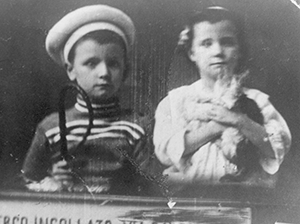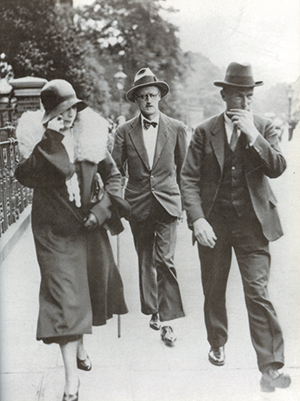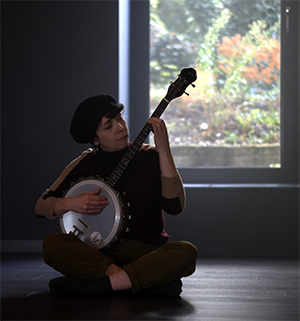‘—LOVE, SAYS BLOOM’
Published in Issue 3 (May/June 2022), Reviews, Volume 30Museum of Literature Ireland (until 3 July 2022)
Curated by Nuala O’Connor
By Donal Fallon
Where does the story of modern Irish literature begin? Any museum of literature in Ireland, never mind the Museum of Literature Ireland (MoLI), will face serious dilemmas of inclusion. One of the first things encountered by a visitor to MoLI is ‘Joyce’s Century’, a room in which portraits of the twentieth- and 21st-century Irish literary canon remind us that much has followed Rathgar’s most famous son. Some faces are familiar to even the most international of visitors; others—like the great Michael Hartnett and Pádraic Ó Conaire—are perhaps better described as domestic icons.
MoLI, from the beginning, has had to contend with the question of Joyce’s prominence in the telling of the story of Irish literature. Originally intended as the ‘Ulysses Centre’, its current name is still something of a nod in the direction of Joyce and the invented Molly Bloom. Yet MoLI has succeeded in striking the fine balance of situating Joyce within the broader story of Irish literature, including plenty of space for literature as Gaeilge.

Above: MoLI has utilised its rotating exhibition to give us Nuala O’Connor’s ‘—Love, says Bloom’, a video and audio exhibition exploring the relationship between James Joyce, Nora Barnacle and their children, Giorgio and Lucia, pictured here at the window of their Trieste apartment c. 1913. (Poetry/Rare Books Collection, University Libraries, State University of New York, Buffalo)
To some, the proposed museum (criticised before even opening its doors) would be ‘another Joycean enterprise to beguile the international tourists visiting the capital city’. Joyce scholar John McCourt, a contributor to RTÉ’s recent landmark documentary on the centenary of Ulysses (reviewed on pp 52–3), has instead noted that ‘much of what MoLI is about is the stimulation of current and future creativity’. A visit to MoLI leaves the visitor with a sense of a living and breathing Irish literature.
Still, 2022 allows us all to give prominence to Ulysses, and to embrace a movement in the ‘decade of centenaries’ towards something new entirely. MoLI has utilised its rotating exhibition space, the room neighbouring ‘Joyce’s Century’, to give us Nuala O’Connor’s ‘—Love, says Bloom’, a video and audio exhibition exploring the relationship between James Joyce, Nora Barnacle and their children, Giorgio and Lucia.
Projecting onto two walls in the room, we are treated to a narrative written by O’Connor on one wall and a series of performances on another. It is an intriguing place to think about Joyce and the course of his life, within what was once the university that educated him. Museums, critical music theorist Simon Reynolds has contended, ‘are primarily visual, oriented around display, designed for the contemplative gaze’. This exhibition is driven not by presented artefacts—there are none, beyond a few images of the family on a mantlepiece—but instead by performance, archival images and words. In that sense, it defies what is expected within a setting like MoLI.

Above: The Joyces in London on their wedding day, 4 July 1931, 27 years after they left Ireland together. ‘—Love, says Bloom’ is, above all else, a celebration of the unwavering love between Nora Barnacle and James Joyce. (NLI)
Music provides us with a unique window into the life of the Joyce family. Eight decades have now passed since Louis Gillet wrote of how, to Joyce, ‘music was a language and perhaps even something more. It was an atmosphere, a condition of thought, an aura beyond all words.’ Within the pages of Ulysses and other works Joyce utilises song at key moments, while biographers have emphasised the important place of the piano in the family home. ‘—Love, says Bloom’ invites us to sit on one of the couches before the two projections and explore the deep importance of song to the Joyce household. Projecting onto the walls of the museum building itself, rather than onto a screen, is an interesting engagement with the space.
Fittingly, one of the performances comes from Ian Lynch, part of the acclaimed folk-group Lankum but also the presenter of ‘Fire Draw Near’, a podcast that explores the history of folk and traditional songs. Ian sings ‘Oh, the Brown and Yellow Ale’, a favourite song of Joyce’s. His performance comes from the Four Provinces pub in Crumlin, empty beyond his own commanding voice, while Lisa O’Neill gives us ‘The Lass of Aughrim’, a song central to Joyce’s story The Dead. Her performance was recorded in the Space Between, a cultural hub on Fenian Street, which is visually stunning on screen. Both Lisa and Ian are more than able to introduce a number, and historical material features in both of their usual sets, but here the songs all flow freely into one another. There is a continuation at play in the noise, and no narrative voice over, as another wall delivers Nuala’s words. Alongside the contemporary performances, historical digging has added to the presentation. We hear the voice of Giorgio Joyce, while reading of James Joyce’s great joy that John McCormack praised his son as ‘a magnificent bass’.
Sounds, beyond song, are utilised in other ways, too. Static and distortion reminds us of the turbulence of the life of this family, moving across national borders. The final words in Ulysses are not those of Molly Bloom, as so often stated, but ‘Trieste–Zurich–Paris 1914–1921’. The sounds of transportation give us that sense of a never-ending journey. Later, as we learn of Lucia Joyce’s mental illness (she was diagnosed with schizophrenia in the mid-1930s), the soundscape captures the sense of anguish within the household.
Nora Barnacle, her biographer Brenda Maddox noted wryly, ‘is as much a part of Irish mythology as Queen Maeve’. ‘—Love, says Bloom’ is, above all else, a celebration of the unwavering love between Nora Barnacle and James Joyce, with no time for mythology. This year, Nuala O’Connor’s Nora is the chosen title for ‘One City One Book’, an annual celebration of literature in the capital that attempts to spark real engagement with a work across communities. That novel, much like this exhibition, brings life and humanity to Nora and her children. Leaving ‘—Love, says Bloom’ and proceeding through the rest of MoLI, a visitor will later arrive at the first copy of Ulysses, on display behind glass from the collection of the National Library of Ireland. We have a new appreciation for the personal journey that led to its creation, and a new understanding of the importance of family support in that process, thanks to Nuala O’Connor.
Donal Fallon is the author of 14 Henrietta Street: from tenement to suburbia (2021) and the presenter of the ‘Three Castles Burning’ podcast.

















